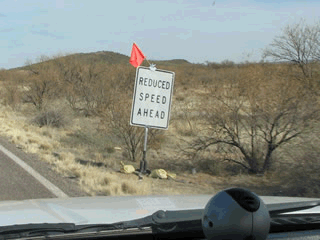
IPFS
'Homeland Security' Checkpoint: Day 3
Written by Terry Bressi Subject: Police StateFor those who think the term seizure is too harsh, let me point out that the U.S. Supreme Court has consistently held that all checkpoint stops are seizures:
A person is seized within the meaning of the Fourth Amendment when by means of physical force or show of authority his freedom of movement is restrained, and in the circumstances surrounding the incident, a reasonable person would believe that he was not free to leave.
As such, these highway chats with Homeland Security agents are much more serious than many would like you to believe.
What's taking place is not a voluntary roadside exchange with well-intentioned law enforcement officers looking out for your safety and security. Rather, these federal agents have temporarily seized your person and property absent a judicial warrant for the sole purpose of conducting an investigation where you are the primary suspect. This despite the fact that no reasonable suspicion exists at the time of the seizure.
Indeed, the whole purpose of the exercise is to create reasonable suspicion by visually searching your vehicle at the same time you are being visually inspected and interrogated regarding your citizenship status.
Finally, consider the following border related points:
* The border doesn't move* The location of the border is easy to determine* In the Tucson sector, there are roughly 300 miles of border and 3,000 Border Patrol agents. That's ten agents for every mile of border* It's easier to secure a 300 mile line than a 30,000 square mile area (interior checkpoints are conducted within 100 miles of the border - for now anyway)
* On the border, there's no need to engage in profiling to try and create reasonable suspicion to justify a stop. If someone is crossing illegally, it's obvious.
In other words, there's no compelling reason to conduct interior suspicionless checkpoints against the traveling public - unless of course one prefers to look good rather than feel good. Interior checkpoints are little more than dog and pony shows designed to entertain the masses while having no discernible impact on the problem they were allegedly created to address.
Getting back to the checkpoint stop in question, I was traveling home from work on January 20th when I was stopped and seized by a Homeland Security Agent at the checkpoint:
The agent initially demanded that I roll down the driver's side window even though he had no legitimate basis to do so. The agent then accused me of veering towards him while I entered the checkpoint and creating a hazard.

After gaining no traction with his baseless claim, he then began demanding my citizenship after refusing to verify his own identity. This continued for a short while until he made it clear he intended to detain me while seeking guidance from a nearby supervisor. The supervisor motioned for the agent to send me through however and I left the checkpoint shortly thereafter.
As I continued my interrupted travels back to Tucson, I began thinking that if the stated goal of the Department of Homeland Security really was to stop illegal border traffic, how much traffic had the department allowed to cross unchallenged forty miles due South of my location over the past two weeks because Border agents were more interested in harassing travelers in the interior of the country than actually patrolling the border.























